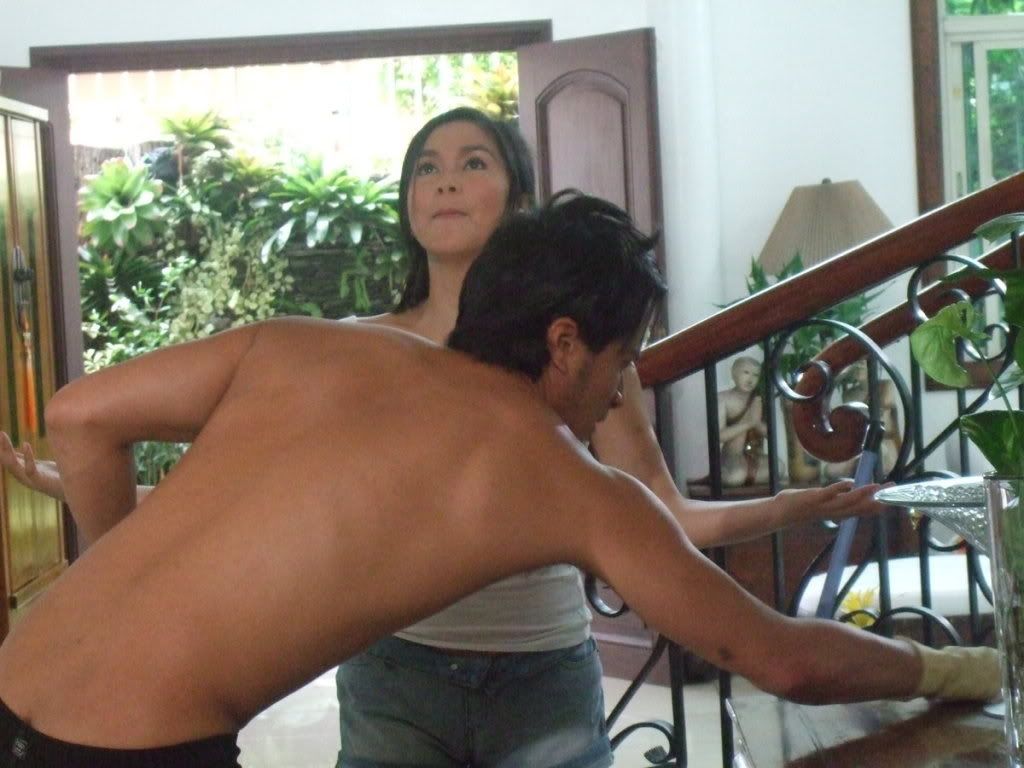Precious Heart Romances (4th Installment): My Cheating Heart Trailer
- Thread starter nikki1786
- Start date
nikki1786
LizQuen
does anyone have the theme song? thank you
these are the list of the theme song for each couple, im still downloading the rest and the other book series haven't aired yet.
so im still looking forward to what songs they'll play for the upcoming book series.... CLICK HERE!
nikki1786
LizQuen
Update:
Roxanne Guinoo backs out and say hello to Kaye Abad's comeback for dramas
We have seen the presscon of Precious Hearts Romances Presents: Bud Brothers Series, the story of 8 guys who owns a Bud Brothers flower farm. it top rated the afternoon dramas since they aired the pilot episode of Bud Brothers Series, Book 1: Stupid Cupids that Jake Cuenca and Cristine Reyes starred.
a lot of happen already since they aired and established the first-teamed up love teams, viewers are now looking forward for more projects of the cast of Book 1, Book 2 and Book 3 since it showed a lot of chemistry with the first-teamed up love teams Jake-Cristine, Rafael-Mariel and John-Denise. sad to say that Cristine Reyes just got back to her home network GMA7 as she plays the villain role of a remake series. though Jake Cuenca's soaring high with his acting stints in his primetime drama that airs from monday-friday 'Tayong Dalawa' (The Two of Us) and has an upcoming horror movie "Villa Estrella" that will show on July 1, 2009. he's also set to do another primetime drama with his co-endorser of vodka drink "The Bar".
with Rafael Rosell and Mariel Rodriguez, the PHR production changed a lot of scenes from the book. but because they're love team is in demand and director Cathy Garcia-Molina pulled the chemistry of the two and it made their book series top rate as it was viewer's choice of love team couple. followed by book 2, is the book 3 that John Prats and Denise Laurel starred, which showed a lot of humor and it made the viewers wanted to see them together. so the book 2 and 3 couples are now visible to see in Bud Brothers Series started in Book 4.
just like what director Cathy Garcia-Molina who directed the Book 2 and 3, she is set to change the sequences from the book to tv-adaption series. direct Cathy also prepared a sequel for Rafael Rosell and Mariel Rodriguez but she wont tell. it only reminded me last year that director Cathy who directed the box-office movie "Very Special Love" that since she received a lot of good feedback from the cast and plot of the movie, it turned out that she announced the sequel of the movie/a part 2. and just last February, "You Changed My Life" is the sequel of the part 1 and it followed that the movie was box-officed and she also won as the box-office director of 2008 and 2009. Now, direct Cathy is up to something again but this time with the PHR cast Rafael and Mariel who gained a lot of fans in an instant because of their chemistry in book 2. the fans still wondering if what kind of sequel that director Cathy's preparing for the viewers/fans.
meanwhile, a lot of changes happened eversince the book 4 was aired. supposedly, Janna Dominguez was teamed up with Manuel Chua for book 5. but she now plays as Tammy of book 4 and partnered with Joem Bascon who plays Pete. Joem was also teamed up with Wendy Valdez but she's now teamed up with Will Devaughn. Valerie Concepcion who now plays Hiromi of book 5 that just started airing awhile ago and partnered with Manuel Chua who play as Ed Lacson. there's a switched happened after the production decided to let them undergo with workshop.

Kaye Abad (left) and Roxanne Guinoo (right)
viewers thought that the PHR production finalized everything, not until Roxanne Guinoo who was given the role to play as Pepper of book 6 and to partnered with Guji Lorenzana who play as Rei. but another announcement just came, when director Cathy is set to direct the book 6. Roxanne Guinoo just recently backs out the afternoon series since she chose to busy with the upcoming primetime drama that was given to her.

meet Kaye Abad, who's also one of channel 2, ABS-CBN's Star Magic homegrown talents. she grew up in ABS-CBN's kids and pre-teen's gag show "Ang TV 2" during 1993. became one of the actresses to look forward to when she was casted in "Gimik" (The Hangout) a teen drama show during 1996 and first teamed up with a love team in a teen drama "Tabing Ilog" (The Creek) during 1999 with John Lloyd Cruz that lasted for 3 years. during late 90's and early 2000, she appeared in many dramas and movies as well. a lot of fans and viewers expects her as she's one of the actresses to look forward to not until she got out of the limelight since a lot of actresses competing at the same time and abs-cbn talents grows much more bigger than ever. looking up for the new ones.
now, Kaye's back to drama stints. she appeared last year as one of the supporting roles in Roxanne Guinoo's afternoon drama "Ligaw Na Bulaklak" (Lost Flower), but for this year's project offered to her is to appear one of the top rated primetime dramas at night "May Bukas Pa" (lit. There's Still Tomorrow) a Marcelino Pan Y Vino Philippine version.

since Roxanne Guinoo backs out the Precious Hearts Romances Presents: Bud Brothers Series that airs from Mondays-Fridays every in the afternoon, direct Cathy announced that the one who will play as Pepper is now Kaye Abad of Book 6: Pepper's Roses to be partnered with Guji Lorenzana who play as Rei. their story is about childhood friends who were enemies since puberty, its just that both Rei and Pepper couldn't connect to each other because of they their attitude. both of their fathers are not only bestfriends but also business partners of a pawnshop and jewelry shop, but since the two end up having a war and planning to divide the shares of the company... Pepper needs to find a way to let the two be friends again. she needed Rei's help whom she can't take his being perfectionist. but in the end Rei agreed with her plan, to pretend as lovers.
Pepper admits that her first love was Rei but that was when they were still in elementary grade, slowly Rei change and she hated the fact that Rei hates her attitude who's wild and free-spirited. it simply indicates that Pepper is not his type of woman. he rather look up for someone, who's more demure and a proper lady. not until, they kiss... he couldn't seem to forget her no matter how he does.
Precious Hearts Romances Presents: Bud Brothers Series
Star Magic Talent's Catalog 2009:
Royalty Page- pictures of actors and actresses who rules the drama series and movies
Reality Page- actors, actresses, dancers and singers who won or joined in ABS-CBN's reality shows. after the show, the talent center offered them to be part of star magic talents whom they think they have future in showbiz. it only shows that they are the product of Star Magic center and the one who manages their career.
Kids Page- Star Magic started during early 90's and they have seen the kids whom they manage are now famous actors and actresses that are visible in movies and dramas. now, they also have the group kids of this generation whom they think has future and one the actors and actresses to look forward to.
Cream Of The Crop Page- these are the mixed of batch 1 to batch 15 talents. every year, they introduce some new batch of Star Magic. just last year, they introduced the batch 16... since the SM center celebrates the 16 years of managing the talents they have.
Fresh Batch Page- the Star Magic talent batch 16 who launched last year.
Roxanne Guinoo backs out and say hello to Kaye Abad's comeback for dramas
We have seen the presscon of Precious Hearts Romances Presents: Bud Brothers Series, the story of 8 guys who owns a Bud Brothers flower farm. it top rated the afternoon dramas since they aired the pilot episode of Bud Brothers Series, Book 1: Stupid Cupids that Jake Cuenca and Cristine Reyes starred.
a lot of happen already since they aired and established the first-teamed up love teams, viewers are now looking forward for more projects of the cast of Book 1, Book 2 and Book 3 since it showed a lot of chemistry with the first-teamed up love teams Jake-Cristine, Rafael-Mariel and John-Denise. sad to say that Cristine Reyes just got back to her home network GMA7 as she plays the villain role of a remake series. though Jake Cuenca's soaring high with his acting stints in his primetime drama that airs from monday-friday 'Tayong Dalawa' (The Two of Us) and has an upcoming horror movie "Villa Estrella" that will show on July 1, 2009. he's also set to do another primetime drama with his co-endorser of vodka drink "The Bar".
with Rafael Rosell and Mariel Rodriguez, the PHR production changed a lot of scenes from the book. but because they're love team is in demand and director Cathy Garcia-Molina pulled the chemistry of the two and it made their book series top rate as it was viewer's choice of love team couple. followed by book 2, is the book 3 that John Prats and Denise Laurel starred, which showed a lot of humor and it made the viewers wanted to see them together. so the book 2 and 3 couples are now visible to see in Bud Brothers Series started in Book 4.
just like what director Cathy Garcia-Molina who directed the Book 2 and 3, she is set to change the sequences from the book to tv-adaption series. direct Cathy also prepared a sequel for Rafael Rosell and Mariel Rodriguez but she wont tell. it only reminded me last year that director Cathy who directed the box-office movie "Very Special Love" that since she received a lot of good feedback from the cast and plot of the movie, it turned out that she announced the sequel of the movie/a part 2. and just last February, "You Changed My Life" is the sequel of the part 1 and it followed that the movie was box-officed and she also won as the box-office director of 2008 and 2009. Now, direct Cathy is up to something again but this time with the PHR cast Rafael and Mariel who gained a lot of fans in an instant because of their chemistry in book 2. the fans still wondering if what kind of sequel that director Cathy's preparing for the viewers/fans.
meanwhile, a lot of changes happened eversince the book 4 was aired. supposedly, Janna Dominguez was teamed up with Manuel Chua for book 5. but she now plays as Tammy of book 4 and partnered with Joem Bascon who plays Pete. Joem was also teamed up with Wendy Valdez but she's now teamed up with Will Devaughn. Valerie Concepcion who now plays Hiromi of book 5 that just started airing awhile ago and partnered with Manuel Chua who play as Ed Lacson. there's a switched happened after the production decided to let them undergo with workshop.

Kaye Abad (left) and Roxanne Guinoo (right)
viewers thought that the PHR production finalized everything, not until Roxanne Guinoo who was given the role to play as Pepper of book 6 and to partnered with Guji Lorenzana who play as Rei. but another announcement just came, when director Cathy is set to direct the book 6. Roxanne Guinoo just recently backs out the afternoon series since she chose to busy with the upcoming primetime drama that was given to her.

meet Kaye Abad, who's also one of channel 2, ABS-CBN's Star Magic homegrown talents. she grew up in ABS-CBN's kids and pre-teen's gag show "Ang TV 2" during 1993. became one of the actresses to look forward to when she was casted in "Gimik" (The Hangout) a teen drama show during 1996 and first teamed up with a love team in a teen drama "Tabing Ilog" (The Creek) during 1999 with John Lloyd Cruz that lasted for 3 years. during late 90's and early 2000, she appeared in many dramas and movies as well. a lot of fans and viewers expects her as she's one of the actresses to look forward to not until she got out of the limelight since a lot of actresses competing at the same time and abs-cbn talents grows much more bigger than ever. looking up for the new ones.
now, Kaye's back to drama stints. she appeared last year as one of the supporting roles in Roxanne Guinoo's afternoon drama "Ligaw Na Bulaklak" (Lost Flower), but for this year's project offered to her is to appear one of the top rated primetime dramas at night "May Bukas Pa" (lit. There's Still Tomorrow) a Marcelino Pan Y Vino Philippine version.

since Roxanne Guinoo backs out the Precious Hearts Romances Presents: Bud Brothers Series that airs from Mondays-Fridays every in the afternoon, direct Cathy announced that the one who will play as Pepper is now Kaye Abad of Book 6: Pepper's Roses to be partnered with Guji Lorenzana who play as Rei. their story is about childhood friends who were enemies since puberty, its just that both Rei and Pepper couldn't connect to each other because of they their attitude. both of their fathers are not only bestfriends but also business partners of a pawnshop and jewelry shop, but since the two end up having a war and planning to divide the shares of the company... Pepper needs to find a way to let the two be friends again. she needed Rei's help whom she can't take his being perfectionist. but in the end Rei agreed with her plan, to pretend as lovers.
Pepper admits that her first love was Rei but that was when they were still in elementary grade, slowly Rei change and she hated the fact that Rei hates her attitude who's wild and free-spirited. it simply indicates that Pepper is not his type of woman. he rather look up for someone, who's more demure and a proper lady. not until, they kiss... he couldn't seem to forget her no matter how he does.
Precious Hearts Romances Presents: Bud Brothers Series
Star Magic Talent's Catalog 2009:
Royalty Page- pictures of actors and actresses who rules the drama series and movies
Reality Page- actors, actresses, dancers and singers who won or joined in ABS-CBN's reality shows. after the show, the talent center offered them to be part of star magic talents whom they think they have future in showbiz. it only shows that they are the product of Star Magic center and the one who manages their career.
Kids Page- Star Magic started during early 90's and they have seen the kids whom they manage are now famous actors and actresses that are visible in movies and dramas. now, they also have the group kids of this generation whom they think has future and one the actors and actresses to look forward to.
Cream Of The Crop Page- these are the mixed of batch 1 to batch 15 talents. every year, they introduce some new batch of Star Magic. just last year, they introduced the batch 16... since the SM center celebrates the 16 years of managing the talents they have.
Fresh Batch Page- the Star Magic talent batch 16 who launched last year.
nikki1786
LizQuen
Update:
Behind the Scenes of Episode 1, Book 5: He's The One.
the married couple Wayne and Betchay's cleaning the house because Wayne's aunt Luz will come to visit them. Wayne tells Betchay that aunt Luz is not just an auntie, but a very specific woman. a woman who travels a lot, to check out the big branches in different countries. Wayne reminds his wife that aunt Luz is very specific and if Betchay wont pass to her standards, then it means she wont pass to Wayne's father's side.










with Direct Don Cueresma who's directing the Book 4: Tail You Lose, Head You're Mine


few shots of BEHIND THE SCENES where Wayne and Betchay cleaning the house. Rafael---> i love the sweat. XD








Behind the Scenes of Episode 1, Book 5: He's The One.
the married couple Wayne and Betchay's cleaning the house because Wayne's aunt Luz will come to visit them. Wayne tells Betchay that aunt Luz is not just an auntie, but a very specific woman. a woman who travels a lot, to check out the big branches in different countries. Wayne reminds his wife that aunt Luz is very specific and if Betchay wont pass to her standards, then it means she wont pass to Wayne's father's side.










with Direct Don Cueresma who's directing the Book 4: Tail You Lose, Head You're Mine


few shots of BEHIND THE SCENES where Wayne and Betchay cleaning the house. Rafael---> i love the sweat. XD








nikki1786
LizQuen
Update:
Bud Brothers Series: He's The One, Episode 1 Screencaps.
Hiromi arrives her flowershop seeing the next shop that is still under construction. she asked one of the contractors if who and what kind of shop that is going to build next to her. just as she got the info from the contractor, she flies away to Bud Brother Flower Farm where the main branch is there. she wanted to see the owners of the Bud Brothers Flower shop that was built right next to her shop.
after the Bud Brothers got her assistant decorator Joel, she felt like the BB guys were trying to show a war on her. so if that's what they want, she'll give what they want.






meanwhile, at the Bud Brothers Flower Farm. Ed's kinda upset with his whole buddies. because his friends only treats him that he has the face quality and charm to convince the customers and mergers for their business. Ed didn't want them to think him that way just because he was a former model in the past. he believes that aside from his face quality, he can do good by running their business not of any charm or smile that his co-BB guys said.
the bud brothers were happy because Ed was the reason why Joel the former decorator of "Petals" is now part of their company and set to expand their business even more. but Ed said that the one that Joel agreed with the contract was the promise to run to the flowershop in Australia.
Hiromi finally arrives in the flower farm to warn them that they maybe today's their happy moments of having a successful business, but wait 'til they see what awaits them for tomorrow. she wasn't even bothered when Pio, Carlo and Ed introduced themselves to her. but the one who caught her attention was Ed, and no doubt that this guy was the one who convinced her decorator Joel to work in their company now. describing him as macho dancer and when he smiles as if he seduces her.






XD
Bud Brothers Series: He's The One, Episode 1 Screencaps.
Hiromi arrives her flowershop seeing the next shop that is still under construction. she asked one of the contractors if who and what kind of shop that is going to build next to her. just as she got the info from the contractor, she flies away to Bud Brother Flower Farm where the main branch is there. she wanted to see the owners of the Bud Brothers Flower shop that was built right next to her shop.
after the Bud Brothers got her assistant decorator Joel, she felt like the BB guys were trying to show a war on her. so if that's what they want, she'll give what they want.






meanwhile, at the Bud Brothers Flower Farm. Ed's kinda upset with his whole buddies. because his friends only treats him that he has the face quality and charm to convince the customers and mergers for their business. Ed didn't want them to think him that way just because he was a former model in the past. he believes that aside from his face quality, he can do good by running their business not of any charm or smile that his co-BB guys said.
the bud brothers were happy because Ed was the reason why Joel the former decorator of "Petals" is now part of their company and set to expand their business even more. but Ed said that the one that Joel agreed with the contract was the promise to run to the flowershop in Australia.
Hiromi finally arrives in the flower farm to warn them that they maybe today's their happy moments of having a successful business, but wait 'til they see what awaits them for tomorrow. she wasn't even bothered when Pio, Carlo and Ed introduced themselves to her. but the one who caught her attention was Ed, and no doubt that this guy was the one who convinced her decorator Joel to work in their company now. describing him as macho dancer and when he smiles as if he seduces her.






XD
nikki1786
LizQuen
cont.
the innermind theater moment of Hiromi when she almost got slipped and Ed catch her.












Ed: she's cute when she gets mad.
Carlo: she's like KILL BILL.
Ed: it's not KILL BILL... it's a Pussy... Pussycat... but it's not. she's like a Tiger.
Carlo did the roaring sound to tease his friend.
the innermind theater moment of Hiromi when she almost got slipped and Ed catch her.












Ed: she's cute when she gets mad.
Carlo: she's like KILL BILL.
Ed: it's not KILL BILL... it's a Pussy... Pussycat... but it's not. she's like a Tiger.
Carlo did the roaring sound to tease his friend.
nikki1786
LizQuen
cont.
since Hiromi got an invitation from the 'pirates' (Bud Brothers), she didn't bothered to go at first. but she had plan. so she sent them first a PINK coffin and the BB guys got rattled if who sent the coffin, but Ed told them that he already guessed who sent the coffin. and so, just as what he guessed, Hiromi got out of her shop wearing an all black dress to let the BB guys see that the opening event is not to celebrate but to mourn.






since Hiromi got an invitation from the 'pirates' (Bud Brothers), she didn't bothered to go at first. but she had plan. so she sent them first a PINK coffin and the BB guys got rattled if who sent the coffin, but Ed told them that he already guessed who sent the coffin. and so, just as what he guessed, Hiromi got out of her shop wearing an all black dress to let the BB guys see that the opening event is not to celebrate but to mourn.






hanjieun30
sarNie OldFart
Rafael is sooooo hotttt!!! :drool: :drool:
I can imagine him being one of the Fortalejo men...
I can imagine him being one of the Fortalejo men...
nikki1786
LizQuen
LMAO... donna... if you could only have time, actually the fans of Rafiels go to the set when they knew that Rafael and Mariel has a shoot.Rafael is sooooo hotttt!!! :drool: :drool:
I can imagine him being one of the Fortalejo men...
you can actually text and meet up with them so that you guys can go at the set together. as for me, they already invited me to come. but duh... i said i need to cross the sea before i got there since i live in south.
anyways, i cant wait for Kaye and Guji's turn as Pepper and Rei. woooooh~!!!!!! i love the ending where Pepper was shouting at Rei "i love you" like a fan, because Rei was singing infront of the crowd. but anyways, Kaye changed a lot... i mean its been awhile you know since she hasn't appeared to some dramas. the fact that i was so over with her drama roles.... always the naive roles... XD
this time she'll portray Pepper's character. its wild and... LMAO Kaye's hair got curled... XD anyways, i love Guji...
i was warming up myself for the upcoming book 6 for this week. so last night, i was watching the whole videos that Kaye was in. in short i watched the GIMIK, TABING ILOG and MMK.
i was watching MMK... she was partnered with Diether, but i laugh when i realized that i watched the GIMIK first... which is... Diether's one of the main cast in GIMIK, then Kaye's also part of the GIMIK but shes' still a kid there, while Diether's a college student.
actually, i was waiting for more Wayne and Betchay scenes. but i like Manuel and Valerie's chemistry though, its just that yesterday... while watching the series... always laugh at the part where Hiromi's imagining Ed all over again. XDi enjoy ed and hiromi's chemistry. i can't wait to see what will happen next between them. gosh, i'm getting addicted to bud brothers. i can't wait until the weekdays just to watch bud brothers.
hanjieun30
sarNie OldFart
LOL
if only Batangas is 1-2 hours drive from here then I'd probably be there during their shoots... -_-
I haven't seen yesterday's episode yet... maybe later... lol
if only Batangas is 1-2 hours drive from here then I'd probably be there during their shoots... -_-
I haven't seen yesterday's episode yet... maybe later... lol
nikki1786
LizQuen
Update:
Regine Angeles turned out to be the "Sabel" of the Bud Brothers Series, Book 7: "Once In A Lifetime Love"

The viewers didn't expect to change the cast towards the ending, just like in book 6 of Pepper and Rei's story. Kaye Abad is set to play the role of Pepper and just last Friday, the book 6 was finally released as what will the viewers expect from the story even more.
Another rumored came out when Regine Angeles (grand winner of BENCH model who's also a Star Magic talent) told a fan about her role in PHR. it wasn't so sure if what kind of role did she got in PHR since it specifies the novels that PHR publish and ABS-CBN is set to do a tv-adaption series just like what they did to Rose Tan's novel "Bud Brothers Series". some speculation says Regine was talking about "Sabel's character" which is the last book of Bud Brothers tv-series.
During the promotional the original love team cast was Jake Cuenca-Cristine Reyes for book 1, Rafael Rosell-Mariel Rodriguez for book 2, John Prats-Denise Laurel of book 3, Joem Bascon-Wendy Valdez of book 4, Manuel Chua-Janna Dominguez of book 5, Guji Lorenzana-Roxanne Guinoo of book 6 and Will Devaughn-Valerie Concepcion of book 7. but after they aired the book 1 to 3, all of a sudden a news just came out that book 4, 5 and 7 swapped love teams. so it turned out to be Joem Bascon-Janna Dominguez for book 4, Manuel Chua-Valerie Concepcion for book 5 and Will Devaughn-Wendy Valdez for book 7. meanwhile, the Book 6 of Guji and Roxanne, it was announced that Roxanne did backs out of the show and so they replaced someone to play the character of Pepper and that would be Kaye Abad to watch out for next week.

another rumored just came, since the PHR keep changing the cast... there are speculations that Wendy Valdez is not going to play the character of Sabel in book 7 from now on, so they replaced someone to play the role and that would be Regine Angeles.
 since from all the books, only book 7 has the different settings, not much focus on the flower farm but in other province since the character that Will Devaughn play is to meet the father of his fiance Lily Rose, though his fiance's father didn't approved their relationship. there Monty (Will Devaughn) meets Sabel who's Lily Rose cousin, a psychologist and can interpret dreams. Sabel has a mission, it was Lily Rose's father's command. she needed to drive away Monty but everytime they were together, she dont know why she feel so comfortable with him.
since from all the books, only book 7 has the different settings, not much focus on the flower farm but in other province since the character that Will Devaughn play is to meet the father of his fiance Lily Rose, though his fiance's father didn't approved their relationship. there Monty (Will Devaughn) meets Sabel who's Lily Rose cousin, a psychologist and can interpret dreams. Sabel has a mission, it was Lily Rose's father's command. she needed to drive away Monty but everytime they were together, she dont know why she feel so comfortable with him.
**note: there will be news soon to confirm if Regine's going to play the role of Sabel, because she might play the role
of Lily Rose...
Regine Angeles turned out to be the "Sabel" of the Bud Brothers Series, Book 7: "Once In A Lifetime Love"

The viewers didn't expect to change the cast towards the ending, just like in book 6 of Pepper and Rei's story. Kaye Abad is set to play the role of Pepper and just last Friday, the book 6 was finally released as what will the viewers expect from the story even more.
Another rumored came out when Regine Angeles (grand winner of BENCH model who's also a Star Magic talent) told a fan about her role in PHR. it wasn't so sure if what kind of role did she got in PHR since it specifies the novels that PHR publish and ABS-CBN is set to do a tv-adaption series just like what they did to Rose Tan's novel "Bud Brothers Series". some speculation says Regine was talking about "Sabel's character" which is the last book of Bud Brothers tv-series.
During the promotional the original love team cast was Jake Cuenca-Cristine Reyes for book 1, Rafael Rosell-Mariel Rodriguez for book 2, John Prats-Denise Laurel of book 3, Joem Bascon-Wendy Valdez of book 4, Manuel Chua-Janna Dominguez of book 5, Guji Lorenzana-Roxanne Guinoo of book 6 and Will Devaughn-Valerie Concepcion of book 7. but after they aired the book 1 to 3, all of a sudden a news just came out that book 4, 5 and 7 swapped love teams. so it turned out to be Joem Bascon-Janna Dominguez for book 4, Manuel Chua-Valerie Concepcion for book 5 and Will Devaughn-Wendy Valdez for book 7. meanwhile, the Book 6 of Guji and Roxanne, it was announced that Roxanne did backs out of the show and so they replaced someone to play the character of Pepper and that would be Kaye Abad to watch out for next week.

another rumored just came, since the PHR keep changing the cast... there are speculations that Wendy Valdez is not going to play the character of Sabel in book 7 from now on, so they replaced someone to play the role and that would be Regine Angeles.

**note: there will be news soon to confirm if Regine's going to play the role of Sabel, because she might play the role
of Lily Rose...
nikki1786
LizQuen
I know Cia encouraged us to make something different out of innards and offal. But I'm pretty helpless on this since I really do not cook offals that often. So you would have to forgive me if I make this thoroughly standard fiesta dish. Cia, as mentioned, of Pabulum is currently hosting the 9th edition of Lasang Pinoy.
I had a lot of fun making this I must say. Starting with shopping for the tongue. Now I wouldn't find this in any ol' supermarket around here so off I went to Tooting (no kidding!) which has a very lively (and cheap) market. (I must blog about this place soon). Lots of fresh veggies and fruits plus this is where I get my fix on pork legs (properly cut), goat meat, whole baby back ribs, fresh chicken liver galore, and supermarket-rare offals - all in very reasonable prices. I went in a Halal meat shop and got this big boy of a tongue.

It was more than 14 inches long and ... well ... resembles something like ... oh never mind. Hehehe! Finding a big pot to fit it in was a challenge but I managed to unearth one of my moth-balling-seldom-used stock pots and just about fit it in. The removal of the skin was a joy - not! Reynaldo Alejandro's recipe from The Food of the Philippines (where I adapted this from) said to scrape or peel. Well I scraped and scraped and scraped but most of the white film is still there. So I had to slice it off trying to take off as little and as thinly as possible. After a prolonged struggle with a double dead tongue I finally got it all off! Hurray on to the cooking!
The marinade was quite good, though, I noticed that you can substitute cooking wine or lemon for the vinegars. I bet it would taste great as well. The only problem I encountered was in the browning of the meat since the marinade has sugar hence the residue got burned. I had to wash up the pot pronto before continuing with the sauteing. I know I lost some good flavours with all those drippings washed away but it was burned and I don't want that to ruin the sauce. Other than that everything else was surprisingly a breeze. And I originally thought it would be horrific including the taste and texture of the meat. The first time I had this was when I was 12 years old and even then, even though I had a pretty fussy tastebud I loved that properly tenderly cooked lengua from a relative's wedding banquet. Finally I was able to recreate it ...
Lengua Estofado
1.5 kg beef tongue
*Marinade:
1 tsp peppercorns
1 bay leaf
3 Tbsp cider vinegar or white cooking wine
3 Tbsp soy sauce
3 Tbsp sugar
2 tsp sea salt
1 cup water
3 Tbsp oil
1/4 cup minced garlic
1/2 cup minced onions
1/2 cup finely chopped tomatoes
350 gm potatoes - peeled, quartered and sliced
1 big carrot - peeled and sliced
salt and freshly milled black pepper
1/3 cup pimiento-stuffed olives
1 cup button mushrooms - halved or sliced
1. Boil the tongue in a large pot of water for 20 minutes. (You may cut the tongue in half if it cannot fit). Drain from water and leave until cool enough to handle.
2. Peel off the (usually white) outer skin. You may have to use a very sharp carving knife for this. Trim ends and wash.
3. Combine all marinade ingredients and marinate the tongue for 1 hour or overnight.
4. In a large pot heat the oil and brown the tongue on all sides. Remove and set aside.
5. If the residue in the pot is not burned, use it with the same oil, if it is then clean the pot and heat it up again with about 2 Tbsp oil.
6. Saute garlic for about 2 minutes in gentle heat - *do not* burn it.
7. Turn up the heat and add in the onion, cook for about 4-5 minutes or until translucent.
8. Add in the tomatoes and cook until soft.
9. Put the tongue back in the pot together with the marinade.
10. Add about 1/2 cup water. Bring back to boil and then simmer for 2.5 hours or until tender. Prick the tongue to let the liquid penetrate. You may add more boiling water a little at a time if it is drying out too much.
11. Tip in the potatoes and carrots - cook for about 5 minutes.
12. Add in the mushrooms and cook for another 5 minutes.
13. Just before serving, remove tongue from sauce and slice crosswise. Arrange in a platter and ladle sauce and vegetables on top. Serve hot.
--source: http://desarapen.blogspot.com/2006/04/lp-9...a-estofado.html
Lengua Estofado is a sumptuous braised ox tongue dish.
It has a strong Iberian influence and is cooked in a blend of wine, vinegar and spices.
Cooked in its own natural juice in a tightly covered pan, this dish requires slow cooking over a low flame.
Braised ox tongue is a rare and splendid dining experience that is surprisingly easy to prepare.
It is a popular Filipino fiesta dish which I first became fascinated with many years ago, I attended the birthday of my aunt when I was kid and that's the first time i tasted the dish, it was her specialty. she owns a hotel and this is one of the dishes that is always serve in their hotel chain.
Though you may initially think that the dish is too exotic and no one will try it, don't be reluctant to serve Lengua Estofado at your next dinner party.
A good accompaniment for this dish is seasoned white rice, fresh garden salad and Atchara or pickled green papaya.
hanjieun30
sarNie OldFart
I love lengua estofado!!! :drool: :drool:
damn!! so tired... I just got home... 1st day of school is VERY toxic... -_- I think I'll just watch today's episode tomorrow morning... lol
damn!! so tired... I just got home... 1st day of school is VERY toxic... -_- I think I'll just watch today's episode tomorrow morning... lol
nikki1786
LizQuen
Jake Cuenca photos on Live Chat last June 11, 2009
http://teamkapamilya.multiply.com/photos/a..._Kapamilya_Chat
June 25 will be Manuel Chua and Ahron Villena on Live Chat! see the schedules of chat live in:
http://www.abs-cbn.com/chat-with-your-favo...ilya-stars.aspx
http://teamkapamilya.multiply.com/photos/a..._Kapamilya_Chat
June 25 will be Manuel Chua and Ahron Villena on Live Chat! see the schedules of chat live in:
http://www.abs-cbn.com/chat-with-your-favo...ilya-stars.aspx

